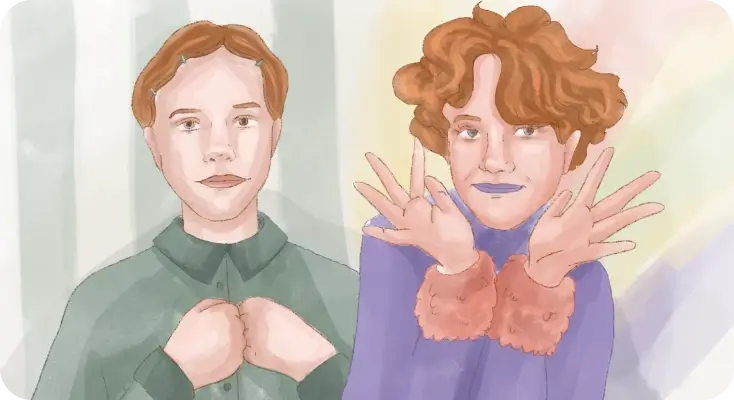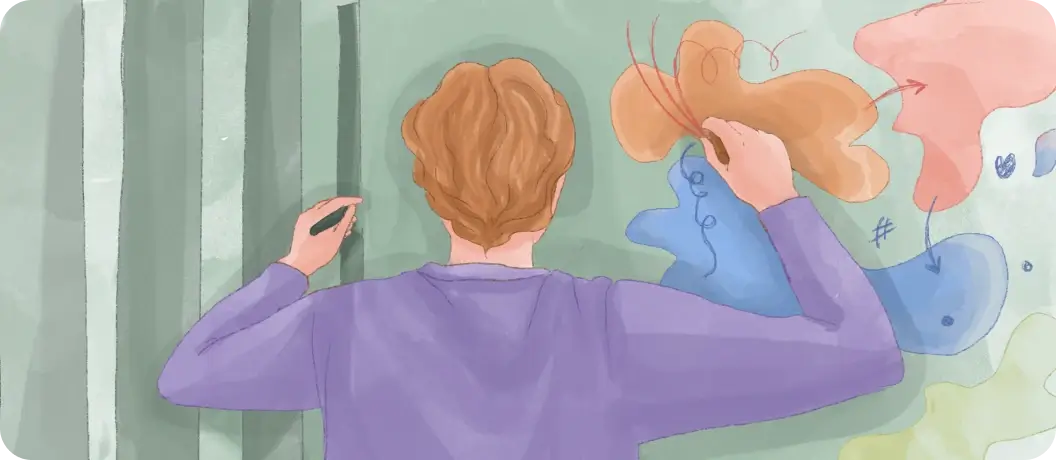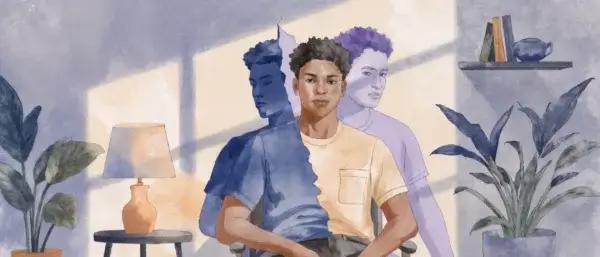These two similar words have pretty different meanings. Impulsive and compulsive sound like identical twins, but in reality, they are more like distant relatives. “But what’s the difference?” you might ask. It’s bigger than you expected.
Stop confusing compulsive and impulsive behavior, understand what you might experience, and find out the causes of both types of behavior. Check out this quick & simple guide.
Impulsive vs. compulsive behavior. Main differences
Impulsive behavior is the tendency to act prematurely, with adverse consequences, or without sufficient evidence to make a decision. [1] This means that a person can’t resist doing some action because they feel that doing it will bring them immediate satisfaction or relief, even if they later regret it or it involves unpredictable consequences. It’s often quick, emotionally charged, and driven by the desire for a reward in the moment.
Compulsive behavior consists of repetitive acts that are characterized by the feeling that one ‘has to’ perform them. [2] It’s often about handling obsessive thoughts and coping with feelings rather than about spontaneous actions. These behaviors can feel more like a burden than a choice, and resisting them usually leads to growing anxiety.
Have you ever experienced impulsive or compulsive behavior?
Impulsivity and compulsivity table for comparison
You go through the shopping mall, see that one golden ring, and buy it immediately, no matter if this is your last money. You love collecting books and always organize them alphabetically. It drives you crazy when something stays in the wrong place.
There’s a noticeable difference between impulsive and compulsive patterns. Let’s compare their irresistible urges in the table to see how close they are.
| Aspect | Impulsive behavior | Compulsive behavior |
| Primary difference | A tendency to act on impulse and without foresight [3] | Repetitive behaviors driven by an intense urge or brain wiring whereby the original goal of the act has been lost [4] |
| Motivation | Feels “rewarding” and comes from a wish to get this reward | Comes from a desire to reduce anxiety and feel safer |
| Pattern | More risk-taken, sudden, and unpredictable | More predictable |
| Personality correlation | May be more typical for extroverted and less organized people | May be more common with anxious individuals |
| Causes | Stems from a lack of self-control and discipline | Stems from a need to regain control and reduce inner tension |
| Negative consequences | Might lead to excessive irresponsibility | Might lead to a lack of flexibility |
A deeper understanding of the difference between compulsive and impulsive behavior
When comparing compulsive vs. impulsive behavior, it’s essential to pay attention to different aspects and patterns of behavior, like predictability, motivation, and influence. Let’s take a closer look at what drives each type, how they show up in everyday life, and what sets them apart.
Motivation
- Impulsive behavior comes from attempts to get pleasure. Someone may buy a new pair of sneakers, book another trip, or grab a dessert on a whim, chasing that instant thrill.
- Compulsive behavior means that a person feels less anxious, rather than safer, after doing something. Checking whether you’ve locked the door 3 times before leaving or cleaning the house for the second time a day — that’s it.
Predictability
- Impulse is hard to predict because it happens spontaneously, with little forethought. For instance, you might decide to quit your job immediately after a stressful meeting.
- Compulsion is very predictable because it’s based on routines or habits. Do you arrange your desk every morning in a super-specific order? That’s it!
Person’s feelings
- After doing something impulsive, people usually feel immediate pleasure and instant gratification, sometimes combined with guilt for doing so.
- Examples of compulsive behavior usually lead to temporary relief from anxiety and the feeling that the situation is under control. The relief is often short-lived, and anxiety may feel greater the next time, causing the person to feel like they have no choice but to do the compulsion.
Long-term influence
- Impulsive behavior can lead to a cycle of quick thrills followed by regret. Over time, this pattern may cause a series of impulsive decisions that do not align with your long-term goals and result in serious life problems.
- Compulsive behavior tends to create a sense of control but can trap you in a loop of never-ending routines. This can lead to perfectionism, a lack of flexibility, and an overwhelming need for control.
Impulsive behavior examples
Well, now the picture gets clearer. Still, comparing impulsive vs. compulsive behavior is impossible without examples. We’ve collected the most common impulses to help you spot them much faster.
- Messaging your ex when you’re drunk or feel lonely
- Starting an argument because of a minor thing when you’re stressed or exhausted
- Saying “yes” to plans you don’t want to go to just to avoid the feeling of missing out
- Grabbing a candy bar at the checkout, even though you promised yourself you’d stick to healthy eating
- Skipping work or responsibilities to binge-watch your favorite show, telling yourself it’s “just for today”
- Sharing a secret because you couldn’t resist the urge to spill the tea
- Drinking alcohol or eating unhealthy foods once you feel stressed, even if you had no intention to — it just feels like the quickest way to get relief
Examples of compulsive behavior
As we’ve looked at impulsive behaviors, let’s dive into compulsive ones. These actions are driven by the need to feel in control or ease anxiety. Here are some examples to help you spot them.
- Thinking and rethinking over a comment you made during a conversation, once it’s finished
- Praying anytime you feel even slightly worried, and believing that otherwise something bad will happen
- Checking your bag repeatedly before leaving the house, making sure your keys, wallet, and phone are there, even though you just checked
- Biting nails, hair pulling, or skin picking too often without even noticing it
- Re-reading a text or email dozens of times before sending it to make absolutely sure it doesn’t have any mistakes
- Constantly scrolling through social media, not out of enjoyment, but to avoid feeling like you’re missing out or to distract yourself from stress
- Compulsive shopping — thinking that something bad will happen if you don’t buy this item right now

Identifying impulse vs. compulsion — Key differences
Now you’re at the crossroads. “What happens to me when I do *a certain kind of thing*?” “Is it impulse or compulsion?” Save these questions to spot compulsive behavior vs. impulsive actions and use them to understand your patterns better.
- Is this behavior driven by an immediate need for pleasure or a desire to reduce stress and anxiety?
- Is this action spontaneous and unpredictable, or part of a rigid routine?
- Do I feel regret or temporary relief after doing it?
- Is it just one moment of indulgence, or does it continue in cycles, creating behavior patterns?
Think about whether you look more like Jordan Belfort from The Wolf of Wall Street, who impulsively buys luxury, or John Nash from A Beautiful Mind, who obsessively looks for patterns in newspapers and math formulas.
Compulsive vs. impulsive behavior. Possible causes
If you can’t simply stop doing something or handle intrusive thoughts without action, it could be a sign that something deep is at play. We’ve collected the most possible causes of compulsive and impulsive behavior, including mental health disorders, coping mechanisms, and reinforced habits.
The most common causes of impulsive behavior
- Attention-deficit/hyperactivity disorder (ADHD)
- Impulse control disorder
- Lack of emotional regulation skills
- Hormonal imbalances or changes
- Peer pressure or social influence
- Borderline personality disorder, [5]
- Bipolar disorder and other mental health disorders
- Environmental influences [6]
- Substance abuse disorders
The most common causes of compulsive behavior
- Obsessive-compulsive personality disorder (OCD)
- Generalized anxiety disorder (GAD)
- Anorexia nervosa
- Body dysmorphic disorder [7]
- Low self-esteem
- Perfectionism
- Need for control
- Imbalance in brain chemistry
Things that can cause examples of both impulsive and compulsive behavior
- Childhood trauma outcomes
- Increased anxiety
- Developmental disorders, such as ASD
- Eating disorders
- High levels of stress or emotional tension
- Genetics or family history of similar behaviors
- Substance abuse or addiction
Everyone is different. Thus, things that make one show impulsive behavior examples, such as booking a last-minute trip after a severe argument with a partner, can make another person organize the wardrobe by colors (for the 5th time a week!). So, if you are looking for the answer to what makes you engage in impulsive or compulsive behaviors, it’s better to seek guidance from a healthcare provider.
Impulsivity and compulsivity. How our mind works
While impulsions and compulsions might seem challenging to differentiate immediately, from a mental health perspective, they are completely distinct. The essence lies in how our brain works.
Impulsivity
A person with impulsive behavior often acts quickly and without thinking beforehand. Their brain finds it challenging to stop automatic reactions or weigh long-term consequences. This happens because of imbalances in the prefrontal cortex (which handles self-control) and the striatum (which responds to rewards).
The “brakes” (like the prefrontal cortex) are too weak, and the “gas pedal” (dopamine-driven reward systems) is too strong. As such, people might find it challenging to control their actions and make thoughtful choices. This brain-based difficulty in managing urges is especially strong under stress. [8]
Compulsions
Those with compulsive behaviors might have trouble with the brain areas that help with self-control, rewards, and decision-making. Their prefrontal cortex and striatum don’t work as well as they should. As a result, such people find it challenging to resist urges and wait for long-term rewards.
Chemicals in the brain, like dopamine and serotonin, can also play a role — too much or too little of these can make urges stronger and self-control weaker. So even if the person knows a behavior is harmful, it’s hard for them to stop because their brain’s “brake system” isn’t strong enough. [9]
The connection between compulsive and impulsive behavior and mental health conditions
Compulsive and impulsive behaviors often stem from deeper imbalances in how the brain processes emotions. Such reactions may cause various mental illnesses, particularly attention-deficit/hyperactivity disorder (ADHD), obsessive-compulsive disorder (OCD), borderline personality disorder, and substance use disorders.
ADHD
Studies suggest that differences in the brain region thalamus may be one of the causes of impulsivity in ADHD. [10] Even more, interactivity in the prefrontal cortex can make thinking ahead more difficult. [11] As a result, people with ADHD may act quickly or have trouble with tasks that require patience.
Borderline personality disorder
Impulsivity is a key sign of borderline personality disorder (BPD) in DSM-5. [12] People with BPD often experience intense emotional fluctuations and a fragile sense of self. Such emotional instability can lead to impulsive actions. The impulsiveness can be especially strong when such people face the fear of abandonment.
Substance use disorders
Among the causes of substance use disorders might be impairments in the prefrontal cortex, anterior cingulate cortex, and striatum, researchers have proven. This imbalance stems from dysregulation in dopamine, serotonin, and norepinephrine. When neurotransmitters are out of balance, people may engage in impulsive and compulsive behaviors that bring undesirable consequences. [13]
Obsessive-compulsive disorder
Differences in how the orbitofrontal cortex and basal ganglia work may cause OCD. These brain impairments make it harder for people with obsessive-compulsive disorder to stop unwanted thoughts, adapt to new situations, or break habits. As a result, it significantly impacts why they might engage in compulsive behavior. [14]
Compulsive vs. impulsive behavior. How to cope
Most of us may experience an uncontrollable urge to do something. But if you or your loved ones feel uneasy about certain behaviors, it may be a sign that it can’t continue anymore. Here’s what might help you cope with impulsive and compulsive patterns:
- Tracking your mood and noticing emotional triggers that make you engage in impulses or compulsions
- Practicing mindfulness and meditation to gain more control over your thoughts and actions, and avoid undesirable outcomes of driven behaviors
- Adhering to a more variable and rewarding routine to make your life more interesting and reduce the probability of sticking to things or following impulses
- Setting clear goals and boundaries to break the cycle of old habits
- Visiting experienced therapists to learn how to cope with overwhelming feelings
From compulsions to impulsivity. Is it possible?
Interestingly, some people might shift from impulsive to compulsive behaviors over time. For instance, at first, they might do something on a sudden urge — like check the door lock once or twice because of a sudden worry.
This action, if it happened once, is impulsive and may be driven by immediate relief. But later on a person may start to repeat this behavior over and over again, and the brain will start to reinforce the loop. So, the action will become compulsive. After some time, they might find themselves feeling anxious if they don’t check the door lock multiple times.
“Can a person show both compulsive and impulsive behaviors at the same time, and how do these behaviors affect their daily life?” We asked Jessi Gholami, LMSW-C, LCSW-C. “Yes, a person can show both compulsive and impulsive behaviors at the same time. For example, someone with OCD-like tendencies might triple-check that they locked their car door and then also compulsively buy something because they think it’s cool, exciting, or new. These combined behaviors can impact someone’s life because it might indicate their heightened emotional dysregulation (feeling very stressed or anxious) and difficulty stopping immediate urges (which can lead to guilt and perhaps low self-esteem).”
Impulsive vs. compulsive behavior. Seeking help
Yet, there might be situations when nothing seems to help. You feel like a fly in a glass jar and repeat habitual patterns over and over.
In this case, asking for psychological treatment is the best option. A therapist can help you acquire the necessary skills and learn techniques to manage impulsive and compulsive tendencies. There’s always a way out. Sometimes, it just requires a look from another perspective.
Expert Insight
“MH professionals can help someone with compulsive or impulsive tendencies through various means. For example,
1. Cognitive behavioral therapy (changing your thoughts that lead to anxiety or impulsivity)
2. Trauma work to explore where this behavior may have originated and resolve the root cause
3. Mindfulness to increase awareness of triggers and teach ways to control actions
4. Exposure therapy — challenging yourself to feel uncomfortable when you don’t listen to an impulse or compulsion — and working through that discomfort.
5. Medications can help
6. Encouraging you to engage in support groups to help you build accountability and resilience
7. Providing psychoeducation — teaching you ways to understand your behavior so that you can take control over it”
Jessi Gholami
Mental health professional
To sum up
If you find yourself regularly engaging in impulsive or compulsive behavior, it might be time to change it. Try the Breeze app to notice what triggers such reactions and analyze how to avoid those triggers. Also, you can set up a calming routine that will help you handle stress and gain more control over your thoughts and overall life. Small daily changes can lead to lasting shifts in how your brain responds to pressure — and help you feel more in charge.
Sources
- Science Direct. “Impulsivity.” 2018
- Luigjes J, Lorenzetti V, de Haan S, Youssef GJ, Murawski C, Sjoerds Z, van den Brink W, Denys D, Fontenelle LF, Yücel M. “Defining Compulsive Behavior.” 2019
- Psychiatric Times. “Understanding the Differences Between Impulsivity and Compulsivity.” July 2008
- Albertella L, Chamberlain SR, Le Pelley ME, Greenwood LM, Lee RS, Den Ouden L, Segrave RA, Grant JE, Yücel M. “Compulsivity is measurable across distinct psychiatric symptom domains and is associated with familial risk and reward-related attentional capture.” 2020
- Bakhshani NM. “Impulsivity: a predisposition toward risky behaviors.” 2014
- ScienceDirect. “Genetic and environmental influences on impulsivity: A meta-analysis of twin, family and adoption studies.” November 2011
- ScienceDirect. “Conceptualising compulsivity through network analysis: A two-sample study.” November 2023
- Mitchell MR, Potenza MN. “Recent Insights into the Neurobiology of Impulsivity.” 2014
- Blum LD. “Minding our Minds: Obsessive-Compulsiveness, Psychiatry, and Psychology.” 2023
- Bailey T, Joyce A. “The role of the thalamus in ADHD symptomatology and treatment. Appl Neuropsychol Child.” 2015
- Arnsten AF. “The Emerging Neurobiology of Attention Deficit Hyperactivity Disorder: The Key Role of the Prefrontal Association Cortex.” 2009
- Sebastian A, Jacob G, Lieb K, Tüscher O. “Impulsivity in borderline personality disorder: a matter of disturbed impulse control or a facet of emotional dysregulation?” 2013
- Kozak K, Lucatch AM, Lowe DJE, Balodis IM, MacKillop J, George TP. “The neurobiology of impulsivity and substance use disorders: implications for treatment.” 2019
- Grant JE, Chamberlain SR. “Exploring the neurobiology of OCD: clinical implications.” 2020
Disclaimer
This article is for general informative and self-discovery purposes only. It should not replace expert guidance from professionals.
Any action you take in response to the information in this article, whether directly or indirectly, is solely your responsibility and is done at your own risk. Breeze content team and its mental health experts disclaim any liability, loss, or risk, personal, professional, or otherwise, which may result from the use and/or application of any content.
Always consult your doctor or other certified health practitioner with any medical questions or concerns
Breeze articles exclusively cite trusted sources, such as academic research institutions and medical associations, including research and studies from PubMed, ResearchGate, or similar databases. Examine our subject-matter editors and editorial process to see how we verify facts and maintain the accuracy, reliability, and trustworthiness of our material.
Was this article helpful?








